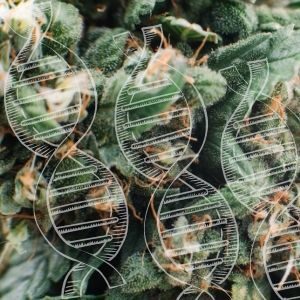Cultivating cannabis requires a blend of art and science with micro and macro nutrients to grow robust, healthy buds. The role of phosphorus for cannabis health and productivity cannot be overstated, as phosphorus is a catalyst that supports critical biochemical reactions that are required for cannabis growth such as nutrient uptake, cannabis metabolism and photosynthesis. Phosphorus is a vital element to maintain the genetic integrity of a cannabis plant from one generation to the next.
 Phosphorus (P): Primary Component of Your Plant’s DNA
Phosphorus (P): Primary Component of Your Plant’s DNA
Phosphorus (P) is a primary component of deoxyribonucleic acid (DNA), the molecule that holds all the genetic code and instructions for cannabis development and reproduction. P is also a main component in ribonucleic acid (RNA), which is the compound that reads the DNA. The DNA, or genetic code, is what builds the functional, structural, and reproductive compounds from early stage development to the flowering stage. Phosphorus bonds link together both DNA and RNA. This genetic make-up is completely dependent on the availability of phosphorus.
P is Essential for All Aspects of Cannabis Development
 P is an essential macro element, which is required for successful development of all life forms, including cannabis plants. P is one of the three most important nutrients for cannabis health, along with Nitrogen (N) and Potassium (K).
P is an essential macro element, which is required for successful development of all life forms, including cannabis plants. P is one of the three most important nutrients for cannabis health, along with Nitrogen (N) and Potassium (K).
P is critical for root development in the early growth stages, strength of the stems, uptake of nutrients, providing resistance to disease and for the formation of flowers and yield. All aspects of cannabis development and growth depend explicitly on the availability of P.
Crucial Functions of Phosphorus for CannabisÂ
There are many reasons why your cannabis plants need phosphorus, which is critical for biochemical reactions including synthesizing proteins and carbohydrates. Some of the most crucial functions of phosphorus for cannabis include:
- Promotes root growth
- Promotes stem strength
- Provides increased resistance to pests and disease
- Increases resistance to frost
- Optimizes water usage in various substrates
- Increases quality of buds and yield
- Improves seed germination
- Reduces vegetative state by boosting root growth
- Aids in production of carbohydrates, improving plant’s metabolism
Cannabis nutrients available for commercial and home growers typically contain formulated amounts of phosphorus which are more than adequate.
Phosphorus DeficienciesÂ
Phosphorus deficiencies are more likely to occur than toxicity, and can result most often from poor soil quality, pH issues, environmental factors, or improper nutrients. Cannabis plants can be affected by a P deficiency at any time during the growth cycle, although are at a higher risk of lacking enough P during the flowering and budding stage. Some signs of a P deficiency include:
- Leaves curling downward
- Older plant leaves darkening, browning, or yellowing
- Leaves with a blotchy or shiny appearance
- Purplish or bright red stems
- Drier, thicker, and stiffer leaves
While a P deficiency can occur, it is uncommon to experience for home growers.
Phosphorus Needs for Early Cannabis Stage DevelopmentÂ
Cannabis plants can live off the nutrients in the seed right after germination, and most commercial soils contain phosphorus in sufficient amounts. When the plants reach about 15 cm in height, about 3 weeks after germination, additional feedings will be required. Providing excessive nutrients too early has the potential to negatively affect the overall health of the seedling and root growth.
Phosphorus Needs for Cannabis Vegetative StateÂ
Phosphorus is internalized by cannabis plants in larger quantities during the budding and flowering stages when your plants are especially hungry. You should still conduct soil tests prior to adding nutrients, although phosphorus is more forgiving when you add a little too much. After about week 4, your cannabis plants will require adequate nutrients rich in potassium, nitrogen, and phosphorus. Exact feeding rates can vary depending on environmental factors, container sizes and cannabis strains, although recommended levels for the vegetative state are about 200 to 250 ppm of potassium, 200 ppm of nitrogen, and 120 ppm of phosphorus. We recommend using commercial cannabis nutrients and sticking to the doses recommended.
Mosca Seeds offers regular seeds, autoflowers, and feminized seeds in a variety of strains with cannabis cup award-winning strains and exciting new drops. Choose from “ein da couchâ” indica, a sativa strain for a little more creative energy, or a blend for the best of both worlds. Check out our seed banks and remember to identify male vs. female cannabis plants when home growing for a successful crop.
